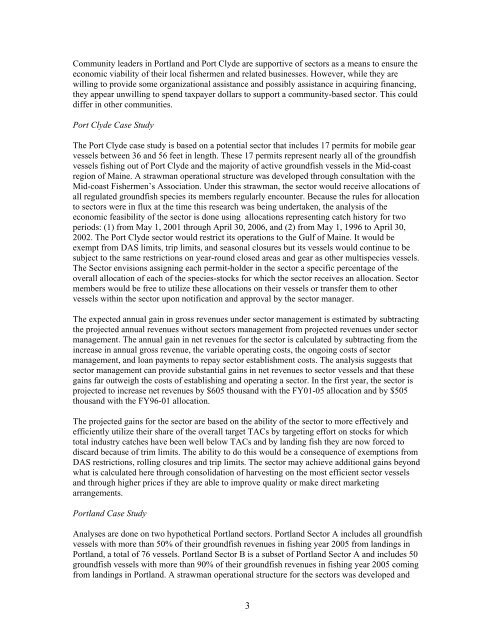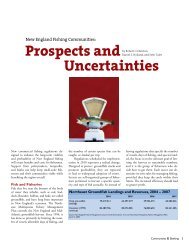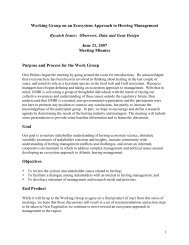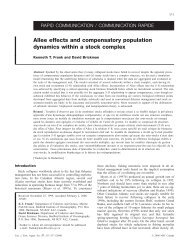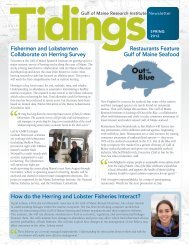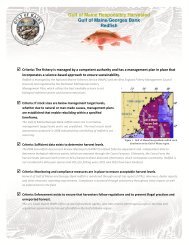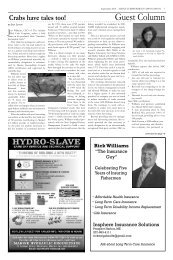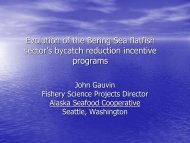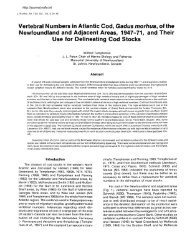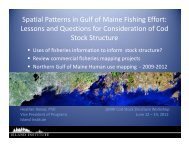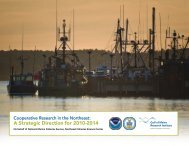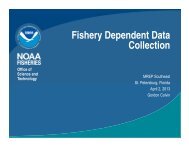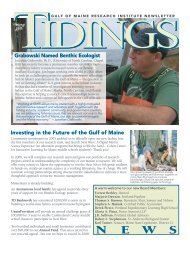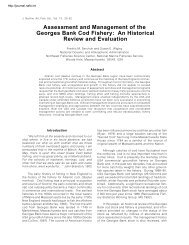Community-based Sectors for the New England Groundfish Fishery
Community-based Sectors for the New England Groundfish Fishery
Community-based Sectors for the New England Groundfish Fishery
Create successful ePaper yourself
Turn your PDF publications into a flip-book with our unique Google optimized e-Paper software.
<strong>Community</strong> leaders in Portland and Port Clyde are supportive of sectors as a means to ensure <strong>the</strong><br />
economic viability of <strong>the</strong>ir local fishermen and related businesses. However, while <strong>the</strong>y are<br />
willing to provide some organizational assistance and possibly assistance in acquiring financing,<br />
<strong>the</strong>y appear unwilling to spend taxpayer dollars to support a community-<strong>based</strong> sector. This could<br />
differ in o<strong>the</strong>r communities.<br />
Port Clyde Case Study<br />
The Port Clyde case study is <strong>based</strong> on a potential sector that includes 17 permits <strong>for</strong> mobile gear<br />
vessels between 36 and 56 feet in length. These 17 permits represent nearly all of <strong>the</strong> groundfish<br />
vessels fishing out of Port Clyde and <strong>the</strong> majority of active groundfish vessels in <strong>the</strong> Mid-coast<br />
region of Maine. A strawman operational structure was developed through consultation with <strong>the</strong><br />
Mid-coast Fishermen’s Association. Under this strawman, <strong>the</strong> sector would receive allocations of<br />
all regulated groundfish species its members regularly encounter. Because <strong>the</strong> rules <strong>for</strong> allocation<br />
to sectors were in flux at <strong>the</strong> time this research was being undertaken, <strong>the</strong> analysis of <strong>the</strong><br />
economic feasibility of <strong>the</strong> sector is done using allocations representing catch history <strong>for</strong> two<br />
periods: (1) from May 1, 2001 through April 30, 2006, and (2) from May 1, 1996 to April 30,<br />
2002. The Port Clyde sector would restrict its operations to <strong>the</strong> Gulf of Maine. It would be<br />
exempt from DAS limits, trip limits, and seasonal closures but its vessels would continue to be<br />
subject to <strong>the</strong> same restrictions on year-round closed areas and gear as o<strong>the</strong>r multispecies vessels.<br />
The Sector envisions assigning each permit-holder in <strong>the</strong> sector a specific percentage of <strong>the</strong><br />
overall allocation of each of <strong>the</strong> species-stocks <strong>for</strong> which <strong>the</strong> sector receives an allocation. Sector<br />
members would be free to utilize <strong>the</strong>se allocations on <strong>the</strong>ir vessels or transfer <strong>the</strong>m to o<strong>the</strong>r<br />
vessels within <strong>the</strong> sector upon notification and approval by <strong>the</strong> sector manager.<br />
The expected annual gain in gross revenues under sector management is estimated by subtracting<br />
<strong>the</strong> projected annual revenues without sectors management from projected revenues under sector<br />
management. The annual gain in net revenues <strong>for</strong> <strong>the</strong> sector is calculated by subtracting from <strong>the</strong><br />
increase in annual gross revenue, <strong>the</strong> variable operating costs, <strong>the</strong> ongoing costs of sector<br />
management, and loan payments to repay sector establishment costs. The analysis suggests that<br />
sector management can provide substantial gains in net revenues to sector vessels and that <strong>the</strong>se<br />
gains far outweigh <strong>the</strong> costs of establishing and operating a sector. In <strong>the</strong> first year, <strong>the</strong> sector is<br />
projected to increase net revenues by $605 thousand with <strong>the</strong> FY01-05 allocation and by $505<br />
thousand with <strong>the</strong> FY96-01 allocation.<br />
The projected gains <strong>for</strong> <strong>the</strong> sector are <strong>based</strong> on <strong>the</strong> ability of <strong>the</strong> sector to more effectively and<br />
efficiently utilize <strong>the</strong>ir share of <strong>the</strong> overall target TACs by targeting ef<strong>for</strong>t on stocks <strong>for</strong> which<br />
total industry catches have been well below TACs and by landing fish <strong>the</strong>y are now <strong>for</strong>ced to<br />
discard because of trim limits. The ability to do this would be a consequence of exemptions from<br />
DAS restrictions, rolling closures and trip limits. The sector may achieve additional gains beyond<br />
what is calculated here through consolidation of harvesting on <strong>the</strong> most efficient sector vessels<br />
and through higher prices if <strong>the</strong>y are able to improve quality or make direct marketing<br />
arrangements.<br />
Portland Case Study<br />
Analyses are done on two hypo<strong>the</strong>tical Portland sectors. Portland Sector A includes all groundfish<br />
vessels with more than 50% of <strong>the</strong>ir groundfish revenues in fishing year 2005 from landings in<br />
Portland, a total of 76 vessels. Portland Sector B is a subset of Portland Sector A and includes 50<br />
groundfish vessels with more than 90% of <strong>the</strong>ir groundfish revenues in fishing year 2005 coming<br />
from landings in Portland. A strawman operational structure <strong>for</strong> <strong>the</strong> sectors was developed and<br />
3


